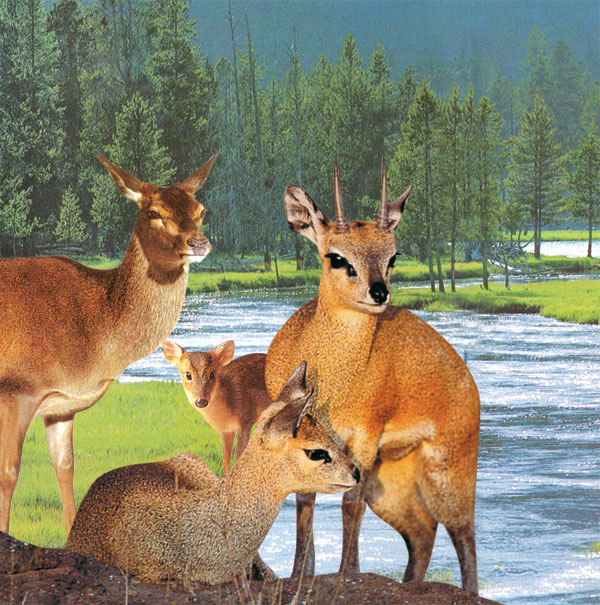The Wondrous Beauty in Animals 4/4
Dolphins protect their young from the moment they are born. Immediately before giving birth, the mother dolphin begins to move more slowly and other female dolphins, seeing this, assist her when she is in labor. These helpers swim on either side of the mother dolphin to protect her and, when the baby is born, make sure that it gets up to the water's surface to take its first breath.
For the first two weeks, the baby never leaves the mother's side. Within a short time after its birth the baby learns to swim and gradually ventures farther and farther away from its mother. The new mother cannot keep up with her baby's swift, rapid movements; and so cannot give it sufficient protection. In this situation, the helper female dolphins come on the scene to provide the baby with excellent defense.30
Creatures caring for one another's welfare is a clear challenge to Darwinists, who believe that this kind of behavior—that is, one creature assisting another—is of no use for an individual animal's survival. On the contrary, they believe that such acts can put a "selfless" animal's life at risk.
The self-sacrificial behavior of mother dolphins can be seen when they put half of their own food, already digested, into the mouths of their babies. Another example of such behavior is dolphins helping one of their number when it is injured. Instead of fleeing, they exhibit behavior that poses considerable risk to their own lives.31
 |
Say: 'Have you thought about your partner gods, those you call upon besides Allah? Show me what they have created of the Earth? ... |
Dolphins act in concert to protect their young from sharks. One or two dolphins will swim out to attract the shark's attention. When the shark turns to follow this decoy, other dolphins attack strongly from other directions; one advances swiftly from behind the others striking the shark's side with their noses. Typically the shark gives up, but dolphins have sometimes even killed sharks in this way.32
Seahorses live on warm ocean reefs where they can hide among the seaweed, coral and sponges. Their thick, hard skin serves as armor against their enemies; they have eyes that can look in several directions at once which help them catch their prey. The male seahorse has a pouch similar to that of the female kangaroo. At mating time, the female seahorse deposits many eggs in this pouch where they remain for six weeks. The male seahorse feeds the eggs in his pouch with a fluid until they develop into miniature seahorses, and he provides oxygen for them by means of capillaries in the inner tissues of the incubation pouch.33
When their mating season comes, sea turtles crawl onto the beach in numbers. But it is not just any beach they come to; it is the beach where they were born. Sometimes they have to travel 800 kilometers (498 miles) to reach their birthplace. At the end of their journey, they lay their eggs and bury them under the sand. So, why do they always gather at the same beach at the same time? If they did so at a different time and on a different beach, would their young survive?
 |
He is Lord of the heavens and the Earth and everything in between them... |
When we try to answer this question, we meet a very interesting situation. The tiny turtles that hatch from the eggs weigh only about 31 grams (1.1 ounce) and a single turtle cannot dig its way up through the layer of sand above them. But with them all helping one another, the job is easily done. Soon they emerge to the surface of the sand altogether and hurry towards the sea.
How do these new hatchlings know that they have to dig through to the top of the sand? Who taught them that they must make their way towards an ocean that they have never seen? These tiny creatures could not do this with their own intelligence, so, where does this conscious behavior come from? There is only one answer to this question: Allah has inspired this conscious behavior into sea turtles.
Meerkats live in communities, and because of the dangers that exist in their environment, their support for one another is of vital importance for their survival. Every morning, meerkats first do a security check before spreading out into the surrounding area to find food.
 |
Truly Allah, He is the Provider, the Possessor of Strength, the Sure. |
Every individual in the community has his own job to do. For example, some meerkats stand guard to ensure the safety of the others, and watch for hours under the blazing sun without eating or drinking anything. If the guard sees some danger, he gives the alarm to warn his friends. Hearing this alarm, the other meerkats run to take refuge in the burrow.
The group's most important task is to rear and protect their young, and the young females are chiefly responsible for looking after the babies. Every day, one of them stays in the burrow to tend the young. The cooperation and mutual assistance in the group ensures that the babies will remain safe.34
It is Allah Who has taught meerkats the supportive and self-denying behavior they show towards one another.
A baby antelope takes between five and ten minutes to be born. During this time, it is difficult for the mother to move, and she is defenseless against her enemies. But while she gives birth, the mother is not alone. All the while there is another female at her side to provide support and protection.
 |
Among His Signs is the creation of the heavens and earth and all the creatures He has spread about in them. And He has the power to gather them together whenever He wills. |
From the moment it is born, the baby has no time to lose. The mother immediately nudges it with her nose to get it to take some steps. But its legs are weak, and it falls down. It gets up again and takes a few more steps. Within a few minutes, it is trotting by its mother's side and never leaves her because if it did, the young antelope would go hungry or be killed by wild animals.35
Everything in nature is the work of the eternal knowledge and power of Allah. With His supreme power, compassion, mercy, intelligence, knowledge and wisdom, He has given baby antelopes the strength to run at their mothers' side within a very short time.
A mother rhinoceros gives birth to a baby that weighs only 4% of her own weight. Within one hour of its birth, a baby rhinoceros can stand up with its little armored body. Mother and baby spend a few weeks in a remote location, apart from others and come to recognize each other's scent.
 |
We have not created the heavens |
Mother and baby spend all their time together until the next baby is born, between three and five years later. The baby rhino mostly follows behind its mother. Even though it stops nursing at two years of age, it still stays at her side and remains with her throughout her next pregnancy. Almighty Allah has given the rhinoceros the instinct to protect and patiently look after her young.36
As a family, the mother cheetah and her offspring are very attached to one another. The mother performs many selfless acts while rearing her young. In order to feed them, she often goes hungry, losing nearly half her weight. If she must, she will even give her own life for her kittens. For example, a lion is a great threat to baby cheetahs. Without hesitation, the mother will throw herself into the lion's path and, putting her own life in jeopardy, she draws the lion's attention away from her young to herself, giving them time to run away. This kind of altruistic behavior calls for consideration.
 |
Say: 'In whose hand is the dominion over everything, He who gives protection and from whom no protection can be given, if you have any knowledge?' |
If this mammal were, as the evolutionists propose, a creature that assembled itself by chance through untold generations and by acting with selfish concern only for its own survival, we would expect it to flee and desert its young. Yet the cheetah does not do this, but confronts the lion and, if necessary, gives up her own life. Surely, it is Allah Who gives mother cheetahs this exemplary sense of self-sacrifice.
Squirrels carry their young in their teeth by the loose skin on their abdomens. If her nest is destroyed, a mother squirrel will carry her babies to another place tirelessly, no matter how far away it is. She carries away one baby and returns to the old nest, time after time, until she is convinced that all have been safely removed.37
 |
He knows everything in the heavens and Earth.He knows what you keep secret and what you divulge.Allah knows what the heart contains. |
They said "Glory be to You!
We have no knowledge except what You have taught us.
You are the All-Knowing, the All-Wise."
(Surat al-Baqara: 32)
Footnotes
30. Janine M. Benyus, The Secret Language and Remarkable Behavior of Animals, p. 313; "Port Phillip Bay's Smiling Ambassadors," Troy Muir; www.polperro.com.au/s9.html)
31. Gordon Rattray Taylor, The Great Evolution Mystery, p. 224.
32. Russell Freedman, How Animals Defend Their Young, p. 66-67.
33. A. Vincent, "The Improbable Seahorse," National Geographic, October 1994, pp. 126-140.
34. "Slender Tailed Meerkat," Wellington Zoo; www.wellingtonzoo.com/animals /animals/mammals/meerkat.html
35. "Antelope," Animal Bytes; www.sandiegozoo.org/animalbyte s/t-antelope.html
36. Janine M. Benyus, The Secret Language and Remarkable Behavior of Animals, p. 186.
37. Red Squirell; www.yptenc.org.uk/docs/factshee ts/animal_facts/red_squirrel.html
